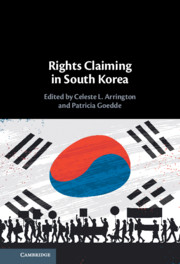Book contents
- Rights Claiming in South Korea
- Rights Claiming in South Korea
- Copyright page
- Dedication
- Contents
- Contributors
- Acknowledgments
- Abbreviations
- Introduction Rights in Action
- Part I Rights in Historical Perspective
- Part II Institutional Mechanisms for Rights Claiming
- 4 A Clash of Claims
- 5 Advancing Human Rights, Advancing a Nation
- 6 The Constitutional Court as a Facilitator of Fundamental Rights Claiming in South Korea, 1988–2018
- 7 Rights Claiming through the Courts
- 8 Public Interest Lawyering in South Korea
- Part III Mobilizing Rights for the Marginalized
- Part IV Shaping Rights for New Citizens and Noncitizens
- Conclusion Findings and Future Directions
- Index
- References
5 - Advancing Human Rights, Advancing a Nation
Becoming a Seonjinguk via the National Human Rights Commission of Korea
from Part II - Institutional Mechanisms for Rights Claiming
Published online by Cambridge University Press: 17 April 2021
- Rights Claiming in South Korea
- Rights Claiming in South Korea
- Copyright page
- Dedication
- Contents
- Contributors
- Acknowledgments
- Abbreviations
- Introduction Rights in Action
- Part I Rights in Historical Perspective
- Part II Institutional Mechanisms for Rights Claiming
- 4 A Clash of Claims
- 5 Advancing Human Rights, Advancing a Nation
- 6 The Constitutional Court as a Facilitator of Fundamental Rights Claiming in South Korea, 1988–2018
- 7 Rights Claiming through the Courts
- 8 Public Interest Lawyering in South Korea
- Part III Mobilizing Rights for the Marginalized
- Part IV Shaping Rights for New Citizens and Noncitizens
- Conclusion Findings and Future Directions
- Index
- References
Summary
This chapter examines human rights policies and their relationship to conceptions of the national interest, focusing on the 2001 establishment and subsequent functioning of the National Human Rights Commission of Korea (NHRCK). The chapter argues that one reason why Korea created and consolidated the NHRCK was to realize its desired identity as a seonjinguk (advanced country). Over time, with changes in political administrations, the definition of a seonjinguk transformed alongside human rights discourses, with implications for the NHRCK’s functioning as a channel for rights-claiming. By tracing the rise and subsequent weakening of the NHRCK from 2001 to 2012, this chapter demonstrates that national interest considerations shape state decisions about whether to comply with or disregard global human rights norms embodied in national human rights institutions like the NHRCK. It also illustrates the interplay between international and domestic human rights discourses.
Keywords
- Type
- Chapter
- Information
- Rights Claiming in South Korea , pp. 106 - 125Publisher: Cambridge University PressPrint publication year: 2021

